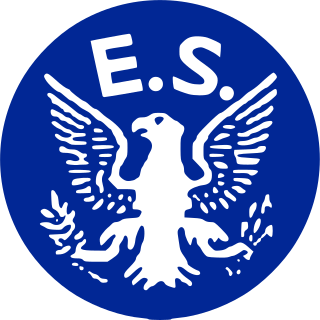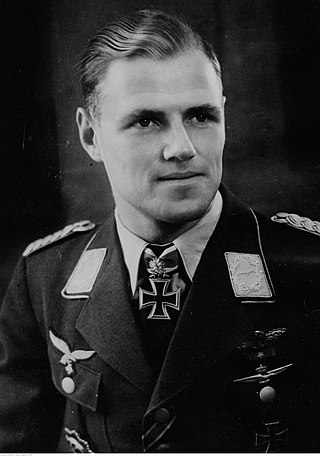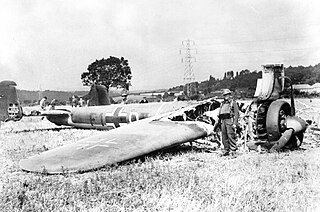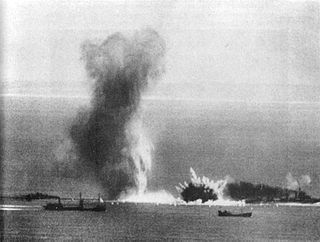
The Eagle Squadrons were three fighter squadrons of the Royal Air Force (RAF) formed with volunteer pilots from the United States during the early days of World War II (1940), prior to the United States' entry into the war in December 1941.

No. 303 Squadron RAF, also known as the 303rd "Tadeusz Kościuszko Warsaw" Fighter Squadron, was one of two Polish squadrons that fought during the Battle of Britain along with No. 302 Squadron, of 16 total Polish squadrons during the Second World War. Flying Hawker Hurricanes, the squadron claimed the largest number of aircraft shot down of the 66 Allied fighter squadrons engaged in the Battle of Britain, even though it joined the fray two months after the battle had begun.

Number 33 Squadron of the Royal Air Force operates the Airbus Helicopters Puma HC.2 from RAF Benson, Oxfordshire.
The Royal Air Force (RAF) and Fleet Air Arm had included personnel from outside the United Kingdom from before the beginning of the Second World War, and many served in the Battle of Britain in summer 1940. Many of these volunteers were British subjects—thus, citizens—coming from territories that made up part of the British Empire. Additionally, a significant part was made up of refugees and exiles from German-occupied Europe and American emigrants.

The Battle of Barking Creek was a friendly fire incident over England on 6 September 1939 that caused the first death of a British fighter pilot in the Second World War.
Royal Air Force Andreas or more simply RAF Andreas is a former Royal Air Force station in the Isle of Man which was operational between 1941 and 1946. It was built in fields between Andreas and Bride in the north of the island. As was common practice, the station was named after the parish in which it was situated.

Joachim Müncheberg was a German Luftwaffe fighter pilot during World War II and an ace credited with 135 air victories. The majority of his victories were claimed over the Western Front, with 33 claims over the Eastern Front. Of his 102 aerial victories achieved over the Western Allies, 46 were against Supermarine Spitfire fighters.

Frank Reginald "Chota" Carey, was a Royal Air Force (RAF) fighter pilot and flying ace who served during World War II.

Wing Commander Alan Geoffrey Page,, known as Geoffrey Page, was an officer in the Royal Air Force who served during the Second World War. He participated in the Battle of Britain, and was shot down. He was badly burned when his aircraft was destroyed, and was lucky to survive. He underwent many surgeries on his way to recovery, and was a founding member of the Guinea Pig Club. He eventually passed a medical exam and returned to active service, becoming one of Britain's most successful fighter pilots.

No. 175 Squadron RAF was a part of 121 Wing; 83 Group; 2nd Tactical Airforce; RAF in support of World War II Normandy landings, and supported the allied advance through France Holland and Belgium on into Germany. The squadron was active from under canvas on temporary landing grounds in a matter of days after the D-Day landings. The squadron initially flew Hawker Hurricane fighters and was later outfitted with Hawker Typhoons prior to the invasion. The squadron was based in various locations during World War II such as RAF Redhill and RAF Dunsfold.

No. 401 Tactical Fighter Squadron, a.k.a. "City of Westmount" Squadron, is a Royal Canadian Air Force squadron based at CFB Cold Lake. During World War II it was a fighter squadron and is notable for having fought in the Battle of Britain. Postwar, the squadron operated in Canada as an auxiliary squadron, reserve squadron and a helicopter and training squadron. In 2015 it was reactivated as a tactical fighter squadron, flying the McDonnell Douglas CF-18 Hornet.

No. 351 Squadron RAF was a Yugoslav Partisan-manned fighter-bomber squadron of the Royal Air Force (RAF) which was operational between 13 October 1944 and 1 May 1945 during World War II. The squadron was also known by the Partisans as Second Squadron (NOVJ).

James Archibald Findlay MacLachlan was a Royal Air Force (RAF) fighter pilot and flying ace of the Second World War. MacLachlan was credited with 16 German and Italian aircraft shot down in approximately 250 missions—7 were at night of which two were achieved over Malta in 1941 and 5 over France in 1942.

The Hardest Day was a Second World War air battle fought on 18 August 1940 during the Battle of Britain between the German Luftwaffe and British Royal Air Force (RAF). On that day, the Luftwaffe made an all-out effort to destroy RAF Fighter Command. The air battles that took place on that day were amongst the largest aerial engagements in history to that time. Both sides suffered heavy losses. In the air, the British shot down twice as many Luftwaffe aircraft as they lost. However, many RAF aircraft were destroyed on the ground, equalising the total losses of both sides. Further large and costly aerial battles took place after 18 August, but both sides lost more aircraft combined on this day than at any other point during the campaign, including 15 September, the Battle of Britain Day, generally considered the climax of the fighting. For this reason, Sunday 18 August 1940 became known as "the Hardest Day" in Britain.

No. 485 (NZ) Squadron was a fighter squadron established for service during the Second World War. It was the first New Zealand squadron formed under Article XV of the Empire Air Training Plan. Although many of its flying personnel were largely drawn from the Royal New Zealand Air Force, the squadron served in Europe under the operational and administrative command of the Royal Air Force.

The Kanalkampf was the German term for air operations by the Luftwaffe against the Royal Air Force (RAF) over the English Channel in July 1940, beginning the Battle of Britain during the Second World War. By 25 June, the Allies had been defeated in Western Europe and Scandinavia. Britain had rejected peace overtures and on 16 July, Adolf Hitler issued Directive 16 to the Wehrmacht, ordering preparations for an invasion of Britain, under the codename Unternehmen Seelöwe.

In late 1937, the Royal Yugoslav Air Force placed an order with Hawker Aircraft for twelve Hawker Hurricane Mk I fighters, the first foreign purchase of the aircraft. The VVKJ operated the British Hawker Hurricane Mk I from 1938 to 1941. Between 1938 and 1940, the VVKJ obtained 24 Hurricane Mk Is from early production batches, marking the first foreign sale of the aircraft. Twenty additional aircraft were built by Zmaj under licence in Yugoslavia. When the country was drawn into World War II by the German-led Axis invasion of April 1941, a total of 41 Hurricane Mk I's were in service as fighters. They achieved some successes against Luftwaffe aircraft, but all Yugoslav Hurricanes were destroyed or captured during the 11-day invasion.

John Arthur Houlton was a New Zealand flying ace of the Royal New Zealand Air Force (RNZAF) during the Second World War. He was credited with the destruction of at least five German aircraft.

Harold Leslie North, was a New Zealand flying ace of the Royal Air Force (RAF) during the Second World War. He was officially credited with the destruction of at least five German aircraft although postwar research indicates some uncertainty regarding his tally.

















